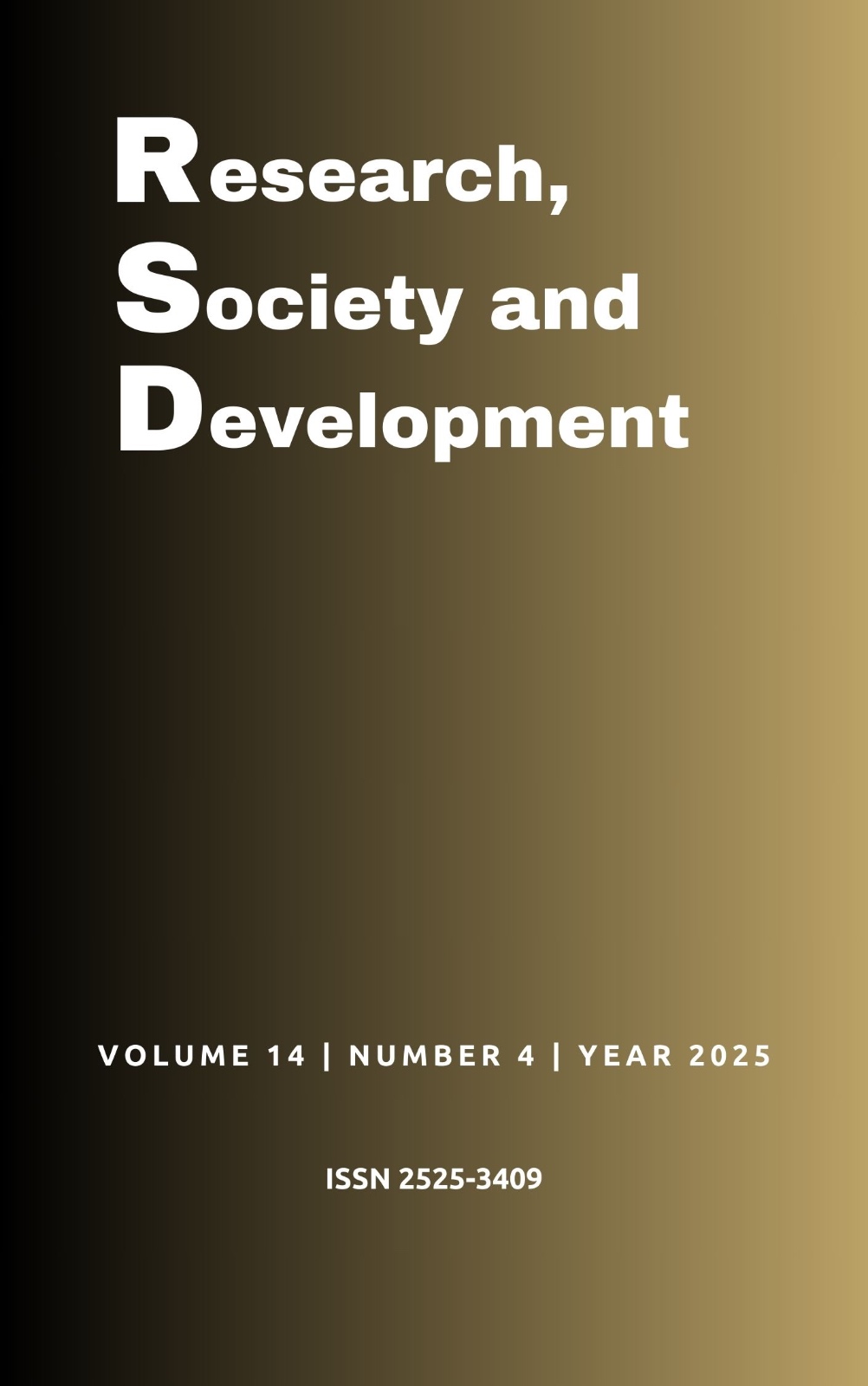Aumento vertical de rebordo alveolar maxilar atrófico: Uma revisão bibliográfica
DOI:
https://doi.org/10.33448/rsd-v14i4.48606Palavras-chave:
Implante Dentário, Aumento Ósseo Vertical, Implante Ósseo Integrado, Rebordo Alveolar.Resumo
Objetivo: A presente revisão de literatura visou avaliar as diferentes técnicas cirúrgicas para aumento vertical de rebordo alveolar em relação à previsibilidade do aumento ósseo, ao risco de complicações, índice de sucesso ou falha dos implantes instalados, bem como a taxa de sobrevida destes. Métodos: Realizou-se uma revisão narrativa da literatura, de natureza qualitativa e, com pouca sistematização e, na qual se fez a busca em que a busca dos dados foi realizada nas bases Scientific Electronic Library Online (SciELO) e National Library of Medicine (PubMed). Resultados: Após a análise dos artigos incluídos na revisão, os resultados dos estudos apontaram a existência de inúmeras técnicas capazes de produzir um ganho significativo de espessura e altura de rebordo alveolar em maxila. Conclusão: Mesmo com a evolução de inúmeras técnicas cirúrgicas, a previsibilidade do aumento vertical de rebordo alveolar permanece um desafio.
Referências
Albrektsson, T., Zarb, G., Worthington, P. & Eriksson, A. R. (1986). The long-term efficacy of currently used dental implants: a review and proposed criteria of success. Int J Oral Maxillofac Implants. 1(1), 11-25.
Bianchi, A., Felice, P., Lizio, G. & Marchetti, C. (2008). Alveolar distraction osteogenesis versus inlay bone grafting in posterior mandibular atrophy: a prospective study. Oral Surg Oral Med Oral Pathol Oral Radiol Endod. 105, 282-92.
Chiapasco, M., Romeo, E., Casentini, P. & Rimondini, L. (2004). Alveolar distraction osteogenesis vs. vertical guided bone regeneration for the correction of vertically deficient edentulous ridges: a 1-3-year prospective study on humans. Clin Oral Implants Res. 15(1), 82-95.
Chiapasco, M., Zaniboni, M. & Rimondini, L. (2007). Autogenous onlay bone grafts vs. alveolar distraction osteogenesis for the correction of vertically deficient edentulous ridges: a 2-4-year prospective study on humans. Clin Oral Implants Res. 18(4), 432-40.
Dennilson, D. K., Vallone, D. R., Pinnero, G. J., RittmanI, B. & Caffesse, R. G. (1994). Differential effect of TGF-beta 1 and PDGF on proliferation of periodontal ligament cells and gingival fibroblasts.J Periodontol. 65(7), 641–8.
Esposito, M., Grusovin, M. G., Felice, P., Karatzopoulos, G., Worthington, H. V. & Coulthard, P. (2009). Interventions for replacing missing teeth: horizontal and vertical bone augmentation techniques for dental implant treatment. Cochrane Database Syst Rev. 7(4), CD003607.
Fontana, F., Santoro, F., Maiorana, C., Iezzi, G., Piattelli, A. & Simion, M. (2008). Clinical and histologic evaluation of allogeneic bone matrix versus autogenous bone chips associated with titanium-reinforced e-PTFE membrane for vertical ridge augmentation: a prospective pilot study. Int J Oral Maxillofac Implants. 23(6), 1003-12.
Huh, J. B., Park, C. K., Kim, S. E., Shim, K. M., Choi, K. H., Kim, S. J., Shim, J. S. & Shin, S. W. (2011). Alveolar ridge augmentation using anodized implants coated with Escherichia coli-derived recombinant human bone morphogenetic protein 2. Oral Surg Oral Med Oral Pathol Oral Radiol Endod. 112(1), 42-9.
Kämmerer, P. W., Palarie, V., Schiegnitz, E., Nacu, V., Draenert, F. G. & Al-Nawas, B. (2012). Influence of a collagen membrane and recombinant platelet-derived growth factor on vertical bone augmentation in implant-fixed deproteinized bovine bone – animal pilot study. Clin Oral Implants Res. 4, 1-9.
Liu, Y., Huse, R. O., de Groot, K., Buser, D. & Hunziker, E. B. (2007). Delivery mode and efficacy of bmp-2 in association with implants. J Dent Res. 86, 84–9.
Pereira A. S. et al. (2018). Metodologia da pesquisa científica. [e-book]. Editora UAB/NTE/UFSM. https://repositorio.ufsm.br/bitstream/handle/1/15824/Lic_Computacao_Metodologia-Pesquisa-Cientifica.pdf?sequence=1.
Polo, C. I., Oliveira Lima, J. L., De Lucca, L., Piacezzi, C. B., Naclério-Homem, M. D., Arana-Chavez, V. E. & Sendyk, W. R. (2013). Effect of Recombinant Human Bone Morphogenetic Protein 2 Associated with a Variety of Bone Substitutes on Vertical Guided Bone Regeneration in Rabbit Calvarium. J Periodontol. 84(3), 360-70. doi: 10.1902/jop.2012.110674. https://pubmed.ncbi.nlm.nih.gov/22524330/.
Rocchietta, I., Fontana, F. & Simion, M. (2008). Clinical outcomes of vertical bone augmentation to enable dental implant placement: a systematic review. J Clin Periodontol. 35(8 Suppl), 203-15.
Roccuzzo, M., Ramieri, G., Bunino, M. & Berrone, S. (2007). Autogenous bone graft alone or associated with titanium mesh for vertical alveolar ridge augmentation: a controlled clinical trial. Clin Oral Implants Res. 18(3), 286-94.
Hollinger, J. O., Hart, C. E. & Hirsch, S. N. (2008). Recombinant human plateletderived growth factor: biology and clinical applications. J Bone Joint SurgAm. 90(suppl 1), 48–54.
Scarano, A., Assenza, B., Di Cerbo, A., Candotto, V., Santos De Oliveira, P. & Lorusso, F. (2017). Bone regeneration in aesthetic areas using titanium micromesh. Three case reports. Oral Implantol (Rome). 10(4), 488-94.
Seibert, J. S. (1983). Reconstruction of deformed, partially edentulous ridges, using full thickness onlay grafts. Part II. Prosthetic/periodontal interrelationships. Compend Contin Educ Dent. 4(6), 549-62.
Downloads
Publicado
Edição
Seção
Licença
Copyright (c) 2025 Daniel Falleiro Simundi; Laiza Naiara Schmitz Simundi

Este trabalho está licenciado sob uma licença Creative Commons Attribution 4.0 International License.
Autores que publicam nesta revista concordam com os seguintes termos:
1) Autores mantém os direitos autorais e concedem à revista o direito de primeira publicação, com o trabalho simultaneamente licenciado sob a Licença Creative Commons Attribution que permite o compartilhamento do trabalho com reconhecimento da autoria e publicação inicial nesta revista.
2) Autores têm autorização para assumir contratos adicionais separadamente, para distribuição não-exclusiva da versão do trabalho publicada nesta revista (ex.: publicar em repositório institucional ou como capítulo de livro), com reconhecimento de autoria e publicação inicial nesta revista.
3) Autores têm permissão e são estimulados a publicar e distribuir seu trabalho online (ex.: em repositórios institucionais ou na sua página pessoal) a qualquer ponto antes ou durante o processo editorial, já que isso pode gerar alterações produtivas, bem como aumentar o impacto e a citação do trabalho publicado.


